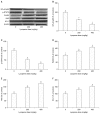Lycopene Protects Against Spontaneous Ovarian Cancer Formation in Laying Hens
- PMID: 29629346
- PMCID: PMC5886492
- DOI: 10.15430/JCP.2018.23.1.25
Lycopene Protects Against Spontaneous Ovarian Cancer Formation in Laying Hens
Abstract
Background: Dietary intake of lycopene has been associated with a reduced risk of ovarian cancer, suggesting its chemopreventive potential against ovarian carcinogenesis. Lycopene's molecular mechanisms of action in ovarian cancer have not been fully understood. Therefore, in the present study, we investigated the effects of lycopene on the ovarian cancer formation using the laying hen model, a biologically relevant animal model of spontaneous ovarian carcinogenesis due to high incidence rates similar to humans.
Methods: In this study, a total of 150 laying hens at age of 102 weeks were randomized into groups of 50: a control group (0 mg of lycopene per kg of diet) and two treatment groups (200 mg or 400 mg of lycopene per kg of diet, or ~26 and 52 mg/d/hen, respectively). At the end of 12 months, blood, ovarian tissues and tumors were collected.
Results: We observed that lycopene supplementation significantly reduced the overall ovarian tumor incidence (P < 0.01) as well as the number and the size of the tumors (P < 0.004 and P < 0.005, respectively). Lycopene also significantly decreased the rate of adenocarcinoma, including serous and mucinous subtypes (P < 0.006). Moreover, we also found that the serum level of oxidative stress marker malondialdehyde was significantly lower in lycopene-fed hens compared to control birds (P < 0.001). Molecular analysis of the ovarian tumors revealed that lycopene reduced the expression of NF-κB while increasing the expression of nuclear factor erythroid 2 and its major target protein, heme oxygenase 1. In addition, lycopene supplementation decreased the expression of STAT3 by inducing the protein inhibitor of activated STAT3 expression in the ovarian tissues.
Conclusions: Taken together, our findings strongly support the potential of lycopene in the chemoprevention of ovarian cancer through antioxidant and anti-inflammatory mechanisms.
Keywords: Chemoprevention; Laying hen model; Lycopene; Ovarian cancer; Transcription factors.
Conflict of interest statement
CONFLICTS OF INTEREST No potential conflicts of interest were disclosed.
Figures



References
-
- Lu KH, Skates S, Hernandez MA, Bedi D, Bevers T, Leeds L, et al. A 2-stage ovarian cancer screening strategy using the Risk of Ovarian Cancer Algorithm (ROCA) identifies early-stage incident-cancers and demonstrates high positive predictive value. Cancer 2013;119:3454–61.10.1002/cncr.28183 - DOI - PMC - PubMed
LinkOut - more resources
Full Text Sources
Other Literature Sources
Miscellaneous
